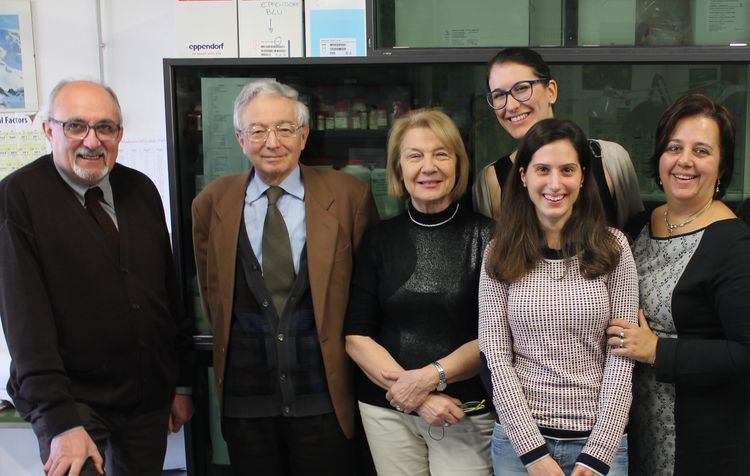
Redox signalling and cancer biomarkers

Research interests are mainly addressed to oxidative stress and more specifically to redox regulation in normal and tumor cells. In particular, the studies are centered on mitochondrial redox regulation in relation with the glutathione and thioredoxin systems and their roles in thiol signalling.
Another research line is on bioactive peptides from food matrices and their role on oxidative stress and redox signalling. The action of antioxidant peptides is studied in a cell system, in particular following the mechanism of activation of Keap1 /Nrf2 pathway. In addition, the relationship between Keap1 /Nrf2 and NF-kB pathways is a topic that we are actively exploring in our lab.
People
Faculty
- Maria Pia RIGOBELLO - Associate Professor
- Valeria SCALCON - Assistant Professor
Lab Members
- Federica TONOLO - Post-doctoral fellow
- Alessandra FOLDA - Research assistant
Awards
- Highly Cited Article of 2012 J. Med. Chem., 55, 11, 2012;
- Highly Cited Paper Coord. Chem. Rev., 253:11-12,1692-1707; 2009
- Highly Cited Paper Redox Biology, 13, 94-162, 2017
- Highly Cited Paper Journal of Functional Foods 64, 2020
Five recent publications
- Hyeraci M, Scalcon V, Folda A, Labella L, Marchetti F, Samaritani S, Rigobello MP. *Dalla Via L*, (2021) New Platinum(II) Complexes Affecting Different Biomolecular Targets in Resistant Ovarian Carcinoma Cells. ChemMedChem 16(12):1956-1966. doi: 10.1002/cmdc.202100075
- Tonolo F.; Moretto L, Grinzato A; Fiorese F; Folda A; Scalcon V; Ferro S; Arrigoni G, Bindoli A, Feller E, Bellamio M, Marin O*, Rigobello MP*. (2020). Fermented soy-derived bioactive peptides selected by a molecular docking approach show antioxidant properties involving the Keap1/Nrf2 pathway. doi:10.3390/antiox9121306. pp.1-21. Antioxidants-: 2076-3921 vol. 9 (12)
- Hyeraci M, Colalillo M, Labella L, Marchetti F, Samaritani S, Scalcon V, Rigobello MP, Dalla Via L. (2020) Platinum(II) complexes bearing triphenylphosphine and chelating oximes: antiproliferative effect and biological profile in resistant cells. ChemMedChem 15(15):1464-147 Doi: 10.1002/cmdc.202000165
- Tonolo F, Fiorese F, Moretto L, Folda A, Scalcon V, Grinzato A, Ferro S, Arrigoni G, Bindoli A, Feller E, Bellamio M, Marin O*, Rigobello MP*. (2020) Identification of new peptides from fermented milk showing antioxidant properties: Mechanism of action. Antioxidants 9(2),117, doi:10.3390/antiox9020117
- Tonolo F, Folda A, Cesaro L, Scalcon V, Marin O, Ferro S, Bindoli A, Rigobello MP*. Milk-derived bioactive peptides exhibit antioxidant activity through the Keap1-Nrf2 signaling pathway, (2020), Journal of Functional Foods 64,103696, doi.org/10.1016/j.jff.2019.103696
- Tonolo F, Salmain M, Scalcon V, Siden Top, Pigeon P, Folda A, Caron B, Mcglinchey MJ, Bindoli A, Jaouen G, Vessières A*, Rigobello MP*. (2019) Small Structural Differences Between Two Ferrocenyl Diphenols Determine Large Discrepancies of Reactivity And Biological Effects. ChemMedChem. 14(19):1717-1726. doi: 10.1002/cmdc.201900430.
- Scalcon V, Tonolo F, Folda A, Bindoli A, Rigobello MP*. Dimers of glutaredoxin 2 as mitochondrial redox sensors in selenite-induced oxidative stress (2019) Metallomics, 11 (7), 1241-1251. DOI: 10.1039/c9mt00090a
- Tonolo F, Moretto L, Ferro S, Folda A, Scalcon V, Sandre M, Fiorese F, Marin O, Bindoli A, Rigobello, MP*. Insight into antioxidant properties of milk-derived bioactive peptides in vitro and in a cellular model. (2019) Journal of Peptide Science, 25 (5), e3162, doi: 10.1002/psc.3162
- Tonolo F, Moretto L, Folda A, Scalcon V, Bindoli A, Bellamio M, Feller E, Rigobello MP*. (2019) Antioxidant Properties of Fermented Soy during Shelf Life. Plant Foods for Human Nutrition, doi: 10.1007/s11130-019-00738-6
- Scalcon V, Bindoli A, Rigobello MP*. (2018) Significance of the mitochondrial thioredoxin reductase in cancer cells: an update on role, targets and inhibitors, Free Radic Biol and Med., 127, 62- 79 doi.org/10.1016/j.freeradbiomed.2018.03.043.




